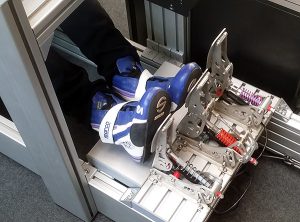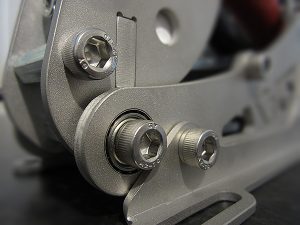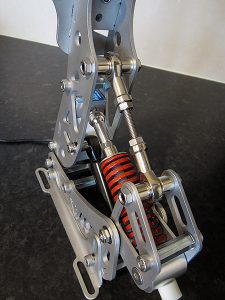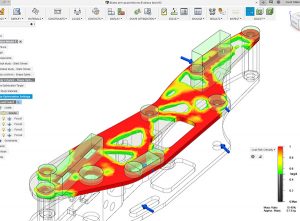
Shortly after this year’s SimRacing Expo at the Nurburgring, we published a blog post about how our latest prototype VRS DirectForce Pro direct drive wheel and pedals were received from our booth at the event. The feedback was extremely positive, and you can find that post here. As promised, in this post we will offer some insight behind the design of the VRS DirectForce Pro Pedals, while you wait for further news.
Our goal with the hardware in general has been as follows: To offer the best performance and functionality out there, without the ultra-premium price tag. We want as many sim racers as possible to enjoy the same hardware as the most hardcore users among us. The pedals are no exception to this, and a great deal of research was spent figuring out what it would take to create the best sim racing pedals available on the market. The bar in recent years has been set very high, so we had a good challenge ahead of us!
Ultimately, we can narrow down the key requirements to:
– Smooth, precise action
– No unintended free play or movement
– High adjustability
– Capable of handling large forces
– Hydraulic feel if desired
– Reliable and consistent response
– Minimal or zero maintenance, durability
– Wide compatibility
– Aesthetically attractive
– High strength-to-weight / size
– Unique design
– Fast order turnaround and availability
We feel like we’ve already achieved most of these, and time will tell how we do on the rest.

Let’s dive into the requirements more closely then. The first being smooth action. In order to deliver on this we’re using shielded and flanged ball bearings in all major pivot points, complete with tolerance ring mountings. This also allows us to hit several of our remaining requirements far more easily, as this eliminates any free play and unwanted movement aside from the desired axis of rotation. They are also maintenance free and extremely hard wearing, and should function well for many many years.
All other joints are PTFE lined with very tight tolerances, again requiring no maintenance (PTFE is essentially self-lubricating) and allowing for no unwanted movement and an ultra-smooth action.
In addition, we’re employing the use of load cells for all pedals. Load cells offer numerous advantages: accuracy, precision, repeatability, reliability, durability, and resistance to dust and dirt. Somewhat uniquely in the market, we are mounting the load cells directly in the pedal arms themselves. This helps to ensure that the force measured by load cells is linearly proportional to the force the driver is exerting on the pedal face. This also allows more room for other components while keeping the overall size nice and compact.

For the brake pedal, we’re also using a unique design, revolving around a metal coil spring for pedal travel response, rather than any rubber bumpers or bushings as are more commonly used in the market currently. Rubbers offer the progressive pedal feel expected from a brake pedal but have shortcomings in respect to maintainability, durability and precision. They are also known to become squeaky over time, yet lubricating them has a small effect on their response curve. Environmental conditions such as humidity and exposure to direct sunlight can impact the properties of rubber. Some drivers describe rubbers feeling “spongy” or “sticky” when trying to finely control pedal pressure. These small details may not be noticeable to the average sim racers but the pro drivers take note of such things (as we saw at the Expo). Finally, rubbers do not have a good durability record under heavy use like in sim racing centres. Knowing all of this, we decided early on that we would stay away from rubbers for the brake pedal and find a metal spring based solution instead.
The use of a coil spring however does present some challenges, namely that they typically provide a linear response, rather than the progressive ramp-up in force which is more typical for a real braking system. Non-linear coil springs do exist but we failed to find one that met our required dimensions, stiffness response and adjustability. We knew a non-linear response could be partially achieved from a linear spring by playing with geometry, but that in order to do so to our requirements we had to introduce an extra mechanism. We were able to achieve this with a special rotating cam assembly. An adjustable control rod allows the end user to easily change the force curve to their liking, specifically the rate of progression or initial force lead-in (more pronounced at the beginning of pedal travel) can be precisely adjusted as desired.
Those who prefer a softer initial brake pedal, with more travel, can enjoy the same pedals as those who might prefer a harder initial response. It’s worth mentioning that this relates to the shape of the force response, and isn’t to be confused with preload. Of course, preload will also be adjustable on all three pedals. Finally, we’ll also provide the option to choose between two different physical springs, to further expand the available pedal stiffnesses and ultimate peak forces. Speaking of which, in the softest configuration, you can expect a decent amount of travel from as little as 20kg, all the way up to 120kg of pedal force with the harder spring. All three pedals will have fully adjustable travel, stiffness, tilt angle and pedal height.
With regards to the clutch pedal, we’re mounting the load cell in an unusual orientation in order to achieve a regressive pedal feel akin to the feeling of a diaphragm spring giving way against a clutch pressure plate in a real car. All three pedals will utilise a custom cnc-machined aluminium spring support, complete with ball bearings for free rotation, that also acts as a bushing for the aligning rod inside the spring. This component allows us to reduce the complexity and size of the design for all three pedals, while ensuring the smoothest possible operation.
Many real world racecars utilise hydraulics for all three pedals, and we will be offering hydraulic dampers to emulate the feeling that this results in. Of course, there will be adjustability for these, and the exact damper design is still a work in progress, with our main aim being minimal free play / movement.

In order to ensure an efficient use of material that copes with the intense forces our pedals may be subjected to, we’ve employed the use of finite element analysis (FEA) and material simulation for our laser-cut and cnc-machined stainless steel parts. This has allowed us to optimise the shape of weight saving cutouts without compromising on strength and stiffness, all the while offering a functional but aesthetically pleasing minimalist appearance.
We understand that many users have unique and varied rigs or cockpits out there, and we’ve tried to consider various different mounting scenarios to ensure compatibility with existing mounting plates and offerings currently out there. Currently we don’t have a pedal plate or footrest of our own yet, but the pedals are very easy to mount to the popular 80/20 style aluminium profile, without a need for a foot / heel rest, and this is exactly how we had them mounted at the recent SimRacing Expo.
We’re more excited than ever to deliver our first units of VRS Directforce Pro Pedals to you all as soon as we can, and are working hard to progress to production as soon as possible. Until then, stay tuned for further updates! To get latest news on VRS DirectForce Pro, follow our Facebook page, or register to our hardware mailing list here.
P.S. For those of you who missed us at the Expo, you can check our pedals out in an interview we had with Leon from The Sim Channel over on youtube:

